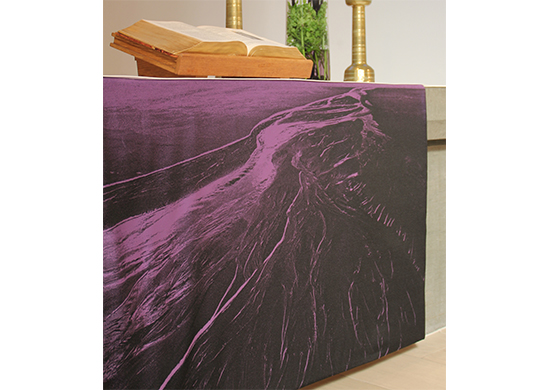Antependium. violett.
Pastor Dr. Uwe Vetter
Violett ist die Farbe der Adventszeit, der Passionswochen und des Buß- und Bettags. Das ist erstaunlich, in der Bibel gibt es nämlich kein eigenes Wort für Violett! Aber der Regenbogen kennt diesen Farbton zwischen blau und rot. Im Orient gewinnt man ihn aus dem Sekret der Purpurschnecken, und je nach dem Verdünnungsgrad entstehen aus einem einzigen Rohstoff ein Rosa oder ein Scharlachrot, ein Grün oder rot schimmerndes Schwarz, und eben das Violett. Vier der fünf liturgischen Farben stammen aus einer Quelle. Sie stehen dem Weiß, der ›Farbe‹ des Christuslichts, gegenüber und treten erst unter diesem Licht aus dem grauen Einerlei heraus. Strenggenommen hat erst das 16. Jahrhundert die Zuordnungen der liturgischen Farben zu den Jahresfestzeiten vorgenommen. Doch sie enthalten uralte biblische Farbgeschichten. Das Zelt der Begegnung, das tragbare Heiligtum der Wüstenwanderung, war in den Purpurtönen blau und rot gefärbt, um farblich den Unterschied zwischen profan und heilig zu markieren. König Salomo ließ zum Bau des ersten Tempels nach einem Kunsthandwerker suchen, »der mit blauem Purpur arbeiten kann«. Violett, das Kind von blau und rot, ist die Farbe der Gottesannäherung.
Das violette Antependium in der Johanneskirche zeigt Muster, wie versickernde Wasserläufe sie hinterlassen. Wie Meer bei Ebbe im Sand filigrane Furchen hinterlässt, zeichnen sich Linien ab, die sich in den Altarraum öffnen. Das Wogen und Rauschen ist verebbt, alles wirkt still. In die Antependium. violett. flachen Senken duckt sich der Schatten eines Lichts, das an die frühste Morgenstunde erinnert. Das Nachtschwarz hebt sich, das Morgenrot beginnt als Dämmerblau, und violett färbt sich die Zeit vor Tagesanbruch. So muss Mose das Farbenspiel jener vierzig Nächte und Tage miterlebt haben, als er sich hoch oben auf dem Berge Sinai auf die Offenbarung der Zehn Gebote vorbereitete. Violett mag sich das erste Morgendämmern aus der Nacht gelöst haben, als Jesus für vierzig Tage und Nächte in der Wüste fastete, um in der Lautlosigkeit ein Gehör für die Stimme Gottes zu
entwickeln. – Es hatte also einen biblischen Grund, dass die Kirche die Farbe violett für die Bußzeiten wählte. Die Adventswochen und die Fastentage vor Ostern haben etwas von Rückzug, Stille und Verharren, bevor wieder etwas Neues, Kraftvolles heranbrandet. Die Bußzeiten des Kirchenjahrs rufen auf, sich zurück zu nehmen und in sich und in seiner Lebenswelt Raum zu schaffen für etwas, das neu beginnt. Bußzeiten sind Zeiten des Verzichts, um hervortreten zu lassen, was zu andern Zeiten von profanen Dingen überflutet wird.
---
Antependium. violet.
Pastor Dr. Uwe Vetter
Violet is the colour of the Advent season, Holy Week and the Day of Prayer and Repentance – an astonishing fact considering the Bible has no independent word for violet. The colour between red and blue is found in rainbows. In the Orient, the dye for it is obtained from secretions of the murex snail, which, depending on how they are diluted, can deliver anything from pink or scarlet to a greenish or pinkish black, or indeed the colour violet. Four of the five liturgical colours are drawn from this secretion and stand in opposition to the fifth, white, the “colour” of the Light of Christ. But it is not until they are illuminated by white light that these hues emerge from the grey monotone.
Strictly speaking colours only became allocated to the liturgical festivals held throughout the year in the 16th century and now encapsulate ancient biblical colour stories. The tent of encounters, a portable sanctuary for those who wander in the desert, was crimson and blue, the constituent colours of purple, to highlight the difference between the profane and the holy. When constructing his first temple, King Solomon ordered artisans to be found who knew how to work with the secretion of the murex snail. And as the child of red and blue, violet is the colour of convergence with God.
The violet parament in the Church of St John is patterned with tidemarks that look as though they were left by water seeping away. Their lines, which resemble the filigree patterns left by waves on the sand at low-tide, open up into the chancel. When the waves and their murmurs subside, everything seems quiet. Shadows nestle in the shallow dips, reminiscent of the earliest morning hours. The blackness of night lifts; the red morning sky emerges from the blue of dawn. Then, just before day breaks, the time turns violet. This symphony of colour must have been what Moses experienced over forty days and nights high up on Mount Sinai as he prepared to receive the Ten Commandments. Violet was quite possibly the colour in which dawn emerged from the night as Jesus fasted in the desert for forty days and nights, as he honed his ear amid the silence to hear the voice of God, as day broke out from the night-time darkness. The fact that violet is the colour chosen to mark festivals of repentance, then, has its origins in the Bible. The Advent season and the fasting period before Easter are both characterised by a sense of withdrawal, of peace and pause before the arrival of something powerful and new. Periods of repentance in the Christian calendar call on us to withdraw and create space for a new beginning within ourselves and within the worlds we live in. Repentance is about renunciation, about letting those things come to the fore that are otherwise obscured by the deluge of profanities.





